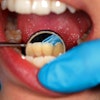Excavations in a cave in Morocco have revealed early evidence of tooth decay in a nut-harvesting hunter-gatherer society, according to a new study (Proceedings of the National Academy of Sciences, January 6, 2014).
Increased reliance on wild plants rich in fermentable carbohydrates caused an early shift toward a disease-associated oral microbiota, wrote the study authors, adding that these findings challenge commonly held assumptions that high rates of caries are indicative of agricultural societies.
"The transition from hunting and gathering to food production is associated with a change in the composition of the oral microbiota and broadly coincides with the estimated timing of a demographic expansion in Streptococcus mutans, a causative agent of human dental caries," they wrote.
They recorded the number of dental caries in hunter-gatherer remains recovered from Grotte des Pigeons in Morocco, and reported that the inhabitants of the site between 13,700 and 15,000 years ago were affected by oral disease, with 51% of recovered adult teeth exhibiting caries.
Further evidence at the site suggests that the inhabitants systematically harvested acorns and pine nuts, both sources of fermentable carbohydrates. The findings challenge the hypothesis that dental caries originated in agricultural societies and suggest that ancient rates of tooth decay comparable with those in modern society are found in ancient populations relying on wild plant foods, according to the authors.















